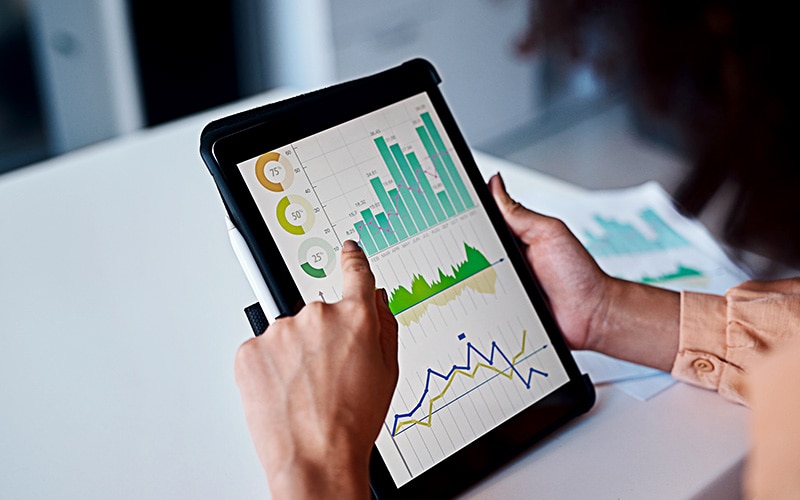Data-driven health care
The health care industry has big problems to solve at a time when its resources are stretched. Digital data may offer solutions. For instance, it may help doctors find better treatments for chronic diseases, which now contributes to about 75% of total U.S. health care spending. Data may also help provide more efficient health care in the face of shrinking numbers of health providers. The American Medical Association expects a shortfall of between 46,900 and 121,900 physicians by 2032 in the U.S.1
Health care data of all kinds is being generated both inside and outside the health care industry. And with more health care data available comes more opportunities for data analysis to be a kind of silver bullet to help solve the industry’s problems. Growing evidence indicates that, when used holistically, data analysis can improve health care prediction, disease prevention and personalization of health care. It can also help with operational design and cost containment by making service provision more targeted and efficient.
The industry is already generating a lot of high-quality data about patients and service provision, thanks to the digital initiatives that have been implemented over the past decade. Meanwhile, patients themselves can create and monitor their health data through readily available wearable consumer technology. Figure 1 shows how different types of data align with the health care journey.
At the macro level, data is also collected by governments and community organizations, aiding understanding of how population, demographic and environmental factors affect health. For example, the U.S. Department of Commerce has data on patients, the census and the weather.2 The Centers for Medicare & Medicaid Services collects health-related data primarily from claims and from patients. This publicly available information can be used by health care stakeholders to understand trends and stratify population risks.
Figure 1. Data sources for holistic health care

Source: Infosys
The health care data could be processed and analyzed holistically to truly improve health outcomes and operational efficiency for health care providers. However, barriers such as a culture of mistrust over data sharing are preventing this from happening. To overcome barriers, health care players are starting to partner across the ecosystem and with technology companies. And in the process, they are building new business models based on the value of data. At the same time, privacy and trust issues are beginning to be tackled. But more needs to be done to effect significant change in data security across the industry.
Data analysis and insights
Factors such as an individual’s genetic composition, socio-economic status, emotional health, lifestyle, drug regimen adherence and physical environment can affect treatments and outcomes.3 Medical sensors, wearables, connected medical devices and digital applications can provide specific real-world data points to understand better how these factors play into health.
Figure 2 describes the standard approach for capturing, processing and deriving insights from across these diverse health care data points. Note that population and personal data sources are two separate streams but join at the point of health interventions.
An interesting thing about data as a resource is that it is renewable and sustainable. New data is generated every day, and with each data point the chance increases of discovering a new diagnosis, therapies, or cost-saving opportunities. Health care data volume quadrupled to 700 exabytes in 2017, from 153 exabytes in 2013. This is expected to triple again to 2,314 exabytes by 2020.4
Figure 2. Digital solutions framework

Source: Infosys
Healthcare data volume is projected to triple from 700 exabytes in 2017 to 2314 exabytes by 2020
And although data can benefit the health care industry in many ways, patient health outcomes will significantly benefit from data. A recent Ernst & Young report pegged the value of data in the U.K.’s National Health Service at a mind-boggling 9.6 billion pounds per year.5 Of this, they estimate 4.6 billion pounds would directly benefit patients by improving their health outcomes. Disease management, personalized medicine and population health are the areas that stand to gain the most from data.
Chronic-disease management
Research indicates that treatment outcomes are positive when patients are actively engaged in their disease treatment journey.6 Technologies make this engagement easier. The ubiquitous use of smartphones and advanced sensor technologies has enabled health care companies to augment drugs with a portfolio of digital therapeutic solutions and wraparound services. Data from these technologies is used primarily to ensure drug adherence, and provide disease coaching and lifestyle interventions.
For example, several major pharmaceutical companies, such as Eli Lilly, Roche and Novo Nordisk, have partnered with digital companies for diabetes management solutions. Connected glucose monitors help patients with diabetes track their blood sugar over time, which helps them manage their medication, and in turn improve their outcomes.
Digital care companies such as San Francisco-based Omada has pioneered digital behavior change programs personalized to support people at risk of developing or living with, chronic conditions such as diabetes and hypertension.7 Omada uses a combination of technology and data science to create a personalized user experience.
Personalized medicine
Genome sequencing enables targeted therapy to be designed for individual patients. It’s particularly helpful in cancer treatment and prevention. For instance, the Swiss company Oncompass helps to identify mutant genes and pinpoint the targeted therapy for the individual.8
Historically, the price for this targeted therapy has been too high for most people. But costs are coming down rapidly. The Boston-based company Veritas offers a full genome sequence for around $600 and estimates that this price will drop to the $100 to $200 range in a couple of years.9 It’s not unrealistic to assume that when this technology becomes mainstream, consumers can use genome sequencing for a much more extensive range of health care issues. It may well become a standard tool for doctors and patients. As targeted therapy grows, it will feed more data into macro population health trends, creating a virtuous cycle.
Population health
According to a recent survey, only one in five health care organizations is currently using analytics for population health. Of those not using analytics, one-third expect that they will use it in the future to focus on population health.10 Population health data is essential to designing and implementing communitywide health initiatives to promote good health practices. This kind of data provides insights into social determinants of health (social, economic, behavioral and environmental factors), which account for more than 70% of health outcomes.11 Understanding these factors is vital to disease prevention by advocating targeted social, behavioral and environmental change programs.
For instance, in 2016, Magellan Health analyzed data to launch an initiative to prevent suicide among its Medicaid beneficiaries in Maricopa County, Arizona. With behavioral health screenings and referrals to mental health services and by addressing social determinants like lack of food or stable housing, they were able to reduce the number of suicides by a remarkable 67% in the first three months.12
Data on social determinants can also help predict demand for health care. For instance, the health advocacy organization PATH is working with the Tanzanian government to pilot the use of machine learning in predicting vaccine demand.13 Given the shortage of vaccines in this region, and with many remote communities, better planning can help with more equitable distribution of medicine.
Health care payers also have an incentive to invest in population health analytics. Data can help them better plan their premiums and follow preventive interventions to reduce their overall health care costs.
Data-centric business models and partnerships
The clear benefits of data analysis in health care are causing a gold rush for access to the right data. Organizations that can most successfully capture and analyze data will be more competitive and effective. But getting access to the right data is not easy. Data-oriented partnerships and collaborations are emerging in the industry so that organizations can get the best data.
In 2018, Roche acquired Flatiron Health, a market leader in oncology-specific electronic health record (EHR) software. Flatiron curated and developed real-world evidence for cancer research.14 Pfizer collaborated with Flatiron Health to use real-world data when it applied for FDA approval for its drug Ibrance. It worked. Ibrance is one of several cancer drugs approved because of EHR and other data, as opposed to FDA applications relying only on clinical studies. The FDA’s move to include real-world evidence and not just clinical trials in granting approvals is noteworthy,15 but so too is the fact that competitors (Roche and Pfizer) teamed up in data-oriented alliances.
Big tech companies are also partnering with industry incumbents and startups in the health care industry. Aetna, a CVS Health company, launched the unique health experience ATTAIN in collaboration with Apple. Aetna members can use an Apple watch with the ATTAIN app to track actions and receive rewards for activities that improve well-being.16 These partnerships also present increased business opportunities for manufacturers of wearable devices to collaborate with insurance companies in developing healthy lifestyles with a focus on prevention.
Marketplaces for anonymous data have also emerged. HealthVerity Marketplace is a cloud-based platform that customers can use to browse and license data from over 50 billion anonymized transactions from more than 330 million U.S. patients. Their customers include pharmaceutical manufacturers, hospitals, payers and retail pharmacies.17
People can also donate their data for research. In late 2018, researchers at Stanford Medicine, in collaboration with Apple, launched a study to determine whether wearable technology could identify irregular heart rhythms that suggest atrial fibrillation. Over 400,000 people voluntarily enrolled to join the study.18
Barriers to sharing data
Perhaps the most significant barrier to the holistic analysis of health care data has to do with ensuring security, privacy and trust. The consensus view is that patients are happy to share data if it results in better health outcomes. However, concerns remain about the risks that this data could be misused to discriminate against people with health issues.
The fear of cybersecurity breaches only compounds the challenge of getting patients to trust the health industry. For instance, in May 2017, the NHS was attacked by WannaCry ransomware.19 Many hospitals were not able to access medical records and had to shut down non-emergency operations. It also led to the canceling of 19,000 appointments.20 Cyber-attacks can be costly. The ransomware cyber-attack cost the NHS 92 million pounds. Health care is a highly regulated industry, and data breaches are expensive. The health care industry pays more than $429 per lost or stolen record on average, which is the highest across industries.21
Health care breaches cost over $429 per record on average
The U.S. has made some big steps toward improving and increasing health care data. The federal initiative MyHealthEData, launched in 2018, aims to empower patients by giving them control of their health care data at every point along their health care journey. Patients can, for instance, give providers secure access to their data to receive better care.
Other U.S. organizations have undertaken projects on data integration. For example, CARIN is a nonprofit dedicated to the consumer-directed exchange of health information. In July 2019, it unveiled its Blue Button HL7 FHIR API model, a program for patients to access claims data.22 Twenty stakeholders, including health care and technology giants such as Apple, Google, Anthem, Microsoft and Humana, have come on board to test this new EHR interoperability initiative.
The biggest cultural hurdle for the health care industry to overcome is the fear that providers will lose out to competition if they share data. However, evidence from other industries suggests that opening up and sharing data results in more innovation and more opportunity.
For example, in the U.K. banking sector, the government introduced open banking regulations that require banks to share data with innovative startup competitors as well as incumbents. This has fostered a rapid surge in the development of fintech business and industry competition. If the health sector follows suit, we can expect similar innovations and benefits through the growth of new “health tech” business models.
References
- https://aamc-black.global.ssl.fastly.net/production/media/filer_public/31/13/3113ee5c-a038-4c16-89af-294a69826650/2019_update_-_the_complexities_of_physician_supply_and_demand_-_projections_from_2017-2032.pdf
- https://data.commerce.gov/
- https://www.who.int/hia/evidence/doh/en/
- https://www.prnewswire.com/news-releases/1145-bn-big-data-in-health care-market-2025-300623544.html
- https://www.ey.com/en_gl/life-sciences/how-we-can-place-a-value-on-health-care-data
- https://implementationscience.biomedcentral.com/articles/10.1186/s13012-018-0784-z
- https://www.omadahealth.com/
- https://www.oncompassmedicine.com/
- https://www.cnbc.com/2019/07/01/for-600-veritas-genetics-sequences-6point4-billion-letters-of-your-dna.html
- https://www.prweb.com/releases/himss_analytics_survey_sponsored_by_dimensional_insight_finds_only_1_out_of_5_healthcare_organizations_using_analytics_for_population_health/prweb16271453.htm
- https://www.ncbi.nlm.nih.gov/pmc/articles/PMC6207436/#b2-18-139
- https://www.modernhealth care.com/article/20180721/TRANSFORMATION02/180729992/insurers-deploy-data-to-advance-population-health-management
- https://www.path.org/articles/ensuring-vaccines-reach-the-people-who-need-them-most/
- https://www.roche.com/media/releases/med-cor-2018-02-15.htm
- https://cancerletter.com/articles/20190419_1/
- https://www.cbinsights.com/research/top-tech-companies-health care-investments-acquisitions/
- https://healthverity.com/solutions/healthverity-marketplace/
- https://med.stanford.edu/news/all-news/2018/11/stanford-apple-describe-heart-study-with-over-400000-participants.html
- https://www.theverge.com/2017/5/12/15630354/nhs-hospitals-ransomware-hack-wannacry-bitcoin
- https://www.telegraph.co.uk/technology/2018/10/11/wannacry-cyber-attack-cost-nhs-92m-19000-appointments-cancelled/
- https://databreachcalculator.mybluemix.net/
- https://www.cnbc.com/2019/07/30/apple-amazon-microsoft-google-sign-on-to-carin-claims-data-standard.html





